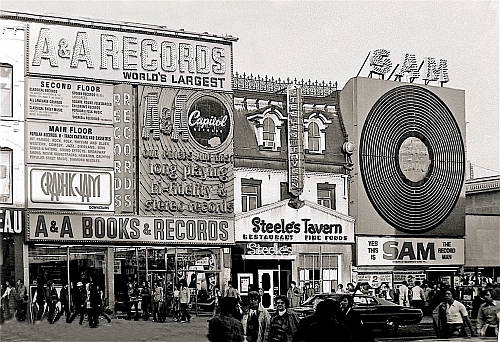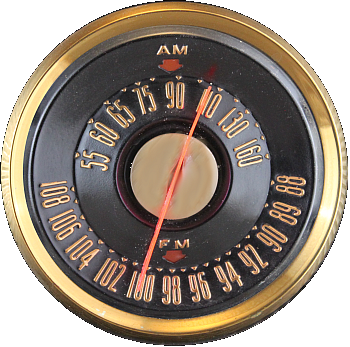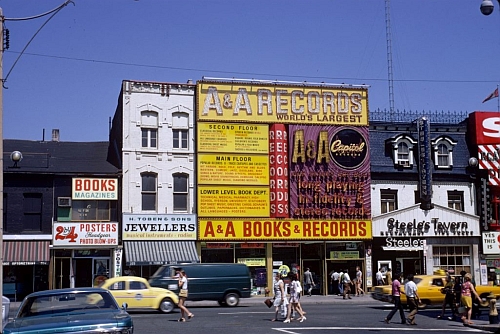An old neon sign from a now-defunct record store in Toronto was in the news recently (2016). It’s been reported that what is described as the “iconic” sign from Sam the Record Man’s flagship store on Yonge Street has been restored and will be erected a few blocks away from its original location. No word on the cost of all this. Ryerson University, (now called Toronto Metropolitan University), which purchased and demolished the old Sam’s location, is footing the bill but it must be in the millions, a lot of money to spend advertising something that doesn’t exist.
The excitement over the sign underscores just how important record stores were to our economy and culture just a couple of generations ago. Our parents may have thought Eaton’s and Simpson’s were the main stores in downtown Toronto, but we all knew it was really Sam’s and A&A Records. The two existed side by side and both were hugely successful retail operations that spread across the country, though both are gone now.
Every major city in the Western world had at least one, a big store downtown that sold nothing but records. They were meeting places, where the tribe gathered, and it was a big tribe so some stores were spectacularly successful, but then burned out. Very few remain now, but they left a lot of good stories.
It’s funny now that Sam the Record Man is viewed as iconic when A&A Records was actually there first, and was the larger of the two for most of their history. A&A was founded in 1945 by Alice Kenner and her brother Aaron as a book store located in a building Alice and her husband owned at 351 Yonge Street. They added a record section in the 1950s and by the 1960s records had taken over the entire business.
Their chief competitor was Sniderman’s Radio Sales, owned by Sidney Sniderman whose brother Sam had also started selling records as a side line in the 1930s from their store on College Street. Again, records soon came to dominate and in 1961 Sam and Sidney made the bold move to open as Sam the Record Man (Sidney the Record Man didn’t sound as good) at 347 Yonge Street, one building south of A&A Records.
 The two stores fed off each other and prospered during the 1960s, 70s and 80s. Sam’s grew faster and became more loved, partly because of their inventive marketing and the fact that Sam very actively promoted Canadian music. Business was so good A&A began to franchise and aggressively opened hundreds of stores across Canada. It didn’t last long; A&A grew too fast without a solid plan and declared bankruptcy in 1991, they briefly recovered but went broke for good in 1993, well before the Internet and file sharing upset the music industry, they only had themselves to blame.
The two stores fed off each other and prospered during the 1960s, 70s and 80s. Sam’s grew faster and became more loved, partly because of their inventive marketing and the fact that Sam very actively promoted Canadian music. Business was so good A&A began to franchise and aggressively opened hundreds of stores across Canada. It didn’t last long; A&A grew too fast without a solid plan and declared bankruptcy in 1991, they briefly recovered but went broke for good in 1993, well before the Internet and file sharing upset the music industry, they only had themselves to blame.
Sam’s later went the same route; their expansion was also dynamic but better planed and at its height, Sam’s accounted for up to 20% of all record sales in Canada. However, they faced tough competition and a changing industry. Sam’s declared bankruptcy in 2001, also recovered briefly but called it quits in 2007.
It’s not a unique story, the same thing happened all over the western world.
In Los Angeles Tower Records started as a family enterprise that was in the right place at the right time. They became a downtown community hub of music lovers that grew into a multi-national empire. They even started their own record label, but they grew too fast, became too big to manage the changes in the industry and don’t exist anymore.
In New York City Sam Gutowitz opened a small record store on 9th Avenue using the name Sam Goody. He made the name famous by selling his records at a discount by mail order. Sam Goody became an institution, but now it’s gone.
In London, England, HMV, a retail operation that seriously got going in 1966 but can trace its roots to the beginning of recording history, established itself as the dominant store and then expanded around the world taking advantage of the new, very profitable CD market. They had deep pockets and pushed a lot of local operations, such as Sam the Record Man, out of business but now even they are struggling.
The oldest record shop in the world is Spillers Records in Cardiff, Wales. The store began in the days of wax cylinders but has survived by always being current, and hip, in its music selection. It ran into trouble in 2006 because, despite being in business since 1894, it was in a leased building and the store’s owner could not afford the skyrocketing rent. Ironically, the increase was spurred by new development in the area which the store itself had helped attract. Musicians, record companies and even the National Assembly of Wales rallied to save the store which was re-located to more affordable digs.
It was a similar story in Toronto in 2007 when Sam the Record Man, now operated by Sam Sniderman’s sons, announced it was closing. The business could not be saved but there was a massive Facebook campaign to save the spinning record neon sign which had lit up that part of Yonge Street since 1969. The building was expropriated by Ryerson University so they could build a new student learning centre. There was no legislation available to force them to save the sign so Toronto City Council made an end run by designating the whole property a heritage site and would only issue a demolition permit if Ryerson undertook to save the sign and re-erect it.
The sign will soon glow again, silent testimony to a whole neighbourhood that was once a record lovers’ Mecca. Besides the two giant stores there was Peter Dunn’s Vinyl Museum next door to A&A, at the time the largest used, or collector, shops in the country (we had pieces of one of their more modest, hand-painted wood signs on display at our store in Orillia). John Norris had his Jazz Blues Record Shop around the corner and then there was Half-Beat Harold’s very off-beat store just up the street. There were many other shops all up and down the strip. In the 1980s it seemed just about anybody, me included, could own a record store in Toronto.
While most of the giant stores from those heady days are gone, the so-called vinyl resurgence has sparked a similar resurgence in smaller, independent record stores. There are several outlets here in Orillia including Alley Cats and Sonic More Records downtown. In Toronto, Kop’s Records, a collectors’ store that has been in business since 1976 recently ditched all their CDs in favour of vinyl and has now expanded to four locations.
A lot of attention is given to vinyl these days (we old guys still call them records) because sales are actually increasing year over year, but it actually makes up a very tiny portion of all recorded music sales. We will never again see the large, multi-level record stores that, like department stores of the era, carried everything, not just the hits but the weird non-hits, foreign language issues, comedy, jazz classical – everything. In so doing they became more than just stores selling product and as the effort to save Sam’s sign proves, we miss them.

